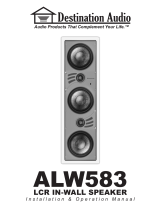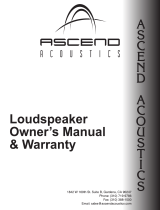Page is loading ...

MC SERIES
O w n e r s M a n u a l

Introduction
MC Series Loudspeakers
Congratulations on your purchase of RBH MC Series loudspeakers! Your
speakers are the result of many years of research and development dedicated
to producing high quality products for home audio and audio/video systems.
This manual contains features, setup recommendations and specications for
MC Series loudspeakers. We recommend you thoroughly read through the
material contained in this manual before connecting your speaker. This will
ensure that you have an understanding of how to setup your speakers for
optimum performance and allow for years of listening enjoyment.
Break In Period
Allow 10-15 hours of listening time to adequately break in the MC Series loud-
speakers. As the speaker breaks in, the driver suspension will loosen. The
result of break-in will be an increase in low frequency response, improved
denition, clarity and detail.

Care and Cleaning
To maintain speaker appearance, we recommend an occasional application
of furniture grade polish to the wood surface of the cabinet. To clean dust from
the grille cloth, use a vacuum with a brush attachment.
Features
At the heart of the MC Series loudspeakers is a proprietary aluminum cone
bass/midrange driver (speaker). The unique aluminum cone material combines
stiffness, low mass and self damping properties in a manner which allows
virtually uncolored presentation of program material. A powerful magnet,
extended voice coil and bumped back plate give the bass/midrange driver
high excursion capability, which ensures accurate dynamic reproduction. The
drivers are shielded by using a steel cup and an additional magnet to cancel
any stray magnetic eld which may cause interference with video equipment
such as tube televisions.
For high frequencies, a proprietary aluminum dome tweeter was developed.
This tweeter uses Ferro Fluid
®
liquid cooling, allowing the tweeter to handle
greater power while retaining detail and accuracy.
Steep acoustic slope crossovers are used to integrate drivers. The use of steep
crossover slopes allows high power handling, minimizes driver interaction
anomalies, and maximizes the clarity with which each driver is able to produce
its respective frequency band. A polyswitch, or current limiting device, is used
in the crossover to prevent damage to the tweeter if overdriven.
Cabinets are constructed of ¾-inch medium density berboard due to its inert
properties, thereby preventing sound coloration due to cabinet diffraction. The
thickness of the front bafes also prevents excess acoustic radiation. Large
oversized gold binding posts ensure a good electrical contact. Sophisticated
computer modeling and measurement techniques are used extensively in the
RBH loudspeaker design process.
Attaching Speaker Wires
When attaching speaker wire to the terminals, it may become necessary to
remove the black and red plastic protective inserts. To do this, loosen the
binder nut from the post by twisting counter-clockwise until the nut is removed
completely from the post. Remove the plastic inserts by pulling straight out.
Replace the nut on the post by twisting clockwise. A hole is then provided
in the top of the post to allow for banana type jacks to slide into. The nut is
tightened until the wire is secure. Remember to strip the insulation from the
wire prior to inserting the wire into the post. Repeat for the other speaker
wire(s) as necessary. (See illustration on following page).

Room Setup Suggestions
In order to extract the best possible sound from your speaker, it is important
to determine where the speakers will sound best in your listening room. Room
reections from the oor, ceiling and side walls inuence the balance, imaging
and overall sonic quality at the listening position. Experiment with speaker
placement to determine which location offers the best overall sound. As a
general guide, use the room layout diagram on the next page and the following
descriptions when setting up a home theater system. Some speakers shown
in the diagram may not be applicable to your individual system.
Front Main Speakers
As a starting point, place your front left and right speakers at least 7 feet apart from
each other. The distance from the listening position to each speaker should be close to
the distance that separates the two main speakers. Angling the speakers slightly inward
towards the listening position may give a more spacious and realistic sound stage.
Center Channel Speaker
The center channel speaker should be placed in the center between both left and
right main speakers. Often this positioning dictates placing the speaker either directly
above or below a television monitor. Since all MC Series bookshelf speakers are video
shielded, the center speaker may be placed close to a television without cause for
concern. If using an MC-414C or MC-616C, the speaker may be in a horizontal (lying
down) or vertical position.
Rear Surround Speakers
The surround speakers should be placed either above or behind the listening position.
If using the MC-44C, it should be placed slightly above and directly to the sides of the listen-
ing position. The listening position should be centered between the surround speakers.
Attaching Speaker Wires (continued)

For best performance with the MC-4C and MC6C models, you may want to experiment
with angling the surround speakers either towards or away from the listening position.
Subwoofer
Placement of the subwoofer will largely determine quality, quantity, and extension of the
bass frequencies within your listening room. Bass frequencies are reinforced by close
room boundaries. Placing the subwoofer in a corner will make the subwoofer sound
louder and boost the very lowest frequencies. Placing the subwoofer away from walls
will provide the least reinforcement, making the bass sound subjectively thinner than
if the woofer were closer to a wall. Good results can usually be obtained by placing a
subwoofer along a wall 1-3 feet from a corner. Experiment with subwoofer placement
and the sub-amplier controls to achieve the proper bass balance.
NOTE: There are several different surround formats available. Dolby Pro-Logic, Pro-Logic II, Dolby
Digital and DTS generally have a 5 speaker plus subwoofer requirement. Dolby Digital EX and DTS
ES add a center rear speaker. Please consult your audio/video professional to determine which
system is best for you and how many speakers you will require.
Room Setup Suggestions

Model: MC- 4C MC- 414C MC- 44C
Frequency Response: 85Hz-20kHz
1
85Hz-20kHz
1
100Hz-20kHz
1
Sensitivity: 84dB
2
88dB
2
88dB
2
Recommended Power: 50-150 Watts 50-150 Watts 50-150 Watts
Woofer: 4” Aluminum Cone
Mid-range Woofer
Two 4” Aluminum Cone
Mid-range Woofers
Two 4” Aluminum Cone
Mid-range Woofers
Tweeter: 1” Aluminum Dome
Tweeter
1” Aluminum Dome
Tweeter
Two 1” Aluminum
Dome Tweeters
Impedance: 8 Ohms 6 Ohms 6 Ohms
Crossover Frequencies: 3000 Hz 3000 Hz 3000 Hz
Dimensions: 8½”H X 5.¼”W X 7¼”D 5¼”H X 14½”W X 7¼”D 10½”W x 9½”H x 6”D
Finish: Black Black Black
Weight: 7½ lbs. 13 lbs. 11 lbs.
Matching RBH Speaker: MC-414C 2-way LCR/
Center Channel
MC-414 2-way In-Wall
Model: MC-6C MC-616C MC-6CT
Frequency Response: 50Hz-20kHz
1
50Hz-20kHz
1
40Hz-20kHz
1
Sensitivity: 87dB
2
89dB
2
87dB
2
Recommended Power: 50-150 Watts 50-150 Watts 50-150 Watts
Woofer: 6½” Aluminum Cone
Mid-range Woofer
Two 6½” Aluminum
Cone Mid-range
Woofers
Three 6½” Aluminum
Cone Mid-range
Woofers
6½” Aluminum Cone
Mid-range Woofer
Tweeter: 1” Aluminum Dome
Tweeter
1” Aluminum Dome
Tweeter
1” Aluminum Dome
Tweeter
Impedance: 6 Ohms 6 Ohms 6 Ohms
Crossover Frequencies: 3000 Hz 3000 Hz 100Hz-3000 Hz
Dimensions: 12½”H X 7¾”W X 8¾”D 7¾”H X19½”W X 8¾”D 40”H X 7¾”W X 11½”D
Finish: Black Black Black
Weight: 17 lbs. 24 lbs. 55 lbs.
Matching RBH Speaker: MC-6 2-way In-Wall MC-616 2-way In-Wall MC-616C 2-way
LCR/Center Channel
1 = ±3dB 2 = 2.83V/1 meter
Specications

Your MC Series theater loudspeaker speakers are covered by a limited
warranty against defects in materials and workmanship for a period of 5 years
from the original date of purchase. This warranty is provided by the authorized
RBH Sound dealer where the speaker was purchased. Warranty repair will
be performed only when your purchase receipt is presented as proof of
ownership and date of purchase. Defective parts will be repaired or replaced
without charge by your dealer’s store or the location designated by your
dealer authorized to service RBH Sound products. Charges for unauthorized
service and transportation cost are not reimbursable under this warranty. This
warranty becomes void if the product has been damaged by alteration, misuse
or neglect. The warrantor assumes no liability for property damage or any
other incidental or consequential damage whatsoever which may result from
the failure of this product. Any and all warranties of merchantability and tness
implied by law are limited to the duration of this express warranty. Some states
do not allow limitations on how long an implied warranty lasts, so the above
limitations may not apply to you. Some states do not allow the exclusion or
limitation of incidental or consequential damages, so the above limitation or
exclusion may not apply to you.
Situation Probable Cause Solution
No sound from speakers. Speaker wire not
connected.
Speaker selector on
amplier is not on.
Make sure wire is properly
connected at both the
speaker and the amplier
observing proper polarity.
Activate proper speaker
selector on amplier.
No sound from one
speaker.
Balance control on
receiver or preamp is
not centered.
Speaker wire not
completely connected.
Place balance control in
the center.
Check all connections at
amplier and speakers.
Only the woofer or
midrange/tweeter are
playing.
Bi-amp clips are not
intact.
Make certain gold bi-amp
clips are in place and
tightened down.
Very little bass and/or
imaging.
Speakers are wired
out of phase.
Check entire system
for proper polarity and
make adjustments as
necessary.
Troubleshooting
Warranty

382 Marshall Way, Layton, Utah • USA • 84041
Toll Free: (800) 543-2205 • Fax: (801) 543-3300
www.rbhsound.com
It is RBH Sound policy to continuously incorporate improvements into products; all specications are subject to change without notice.
Copyright © 2006 RBH Sound. All Rights Reserved.
Redening the Way You Experience Sound.
TM
/


